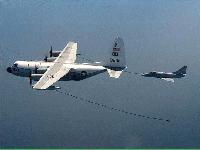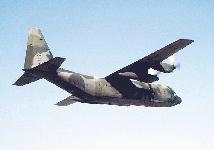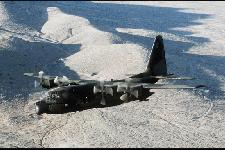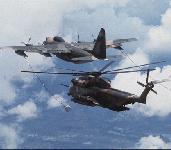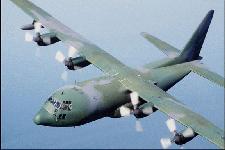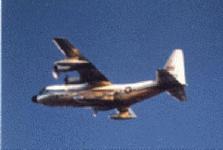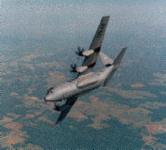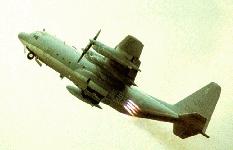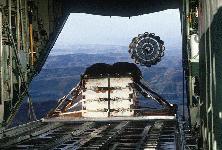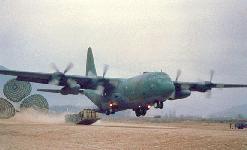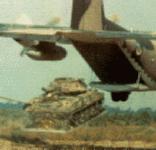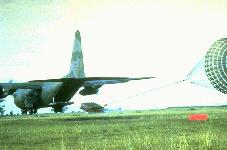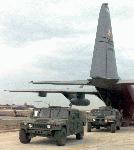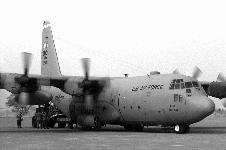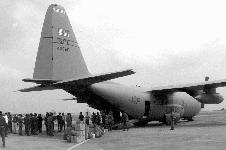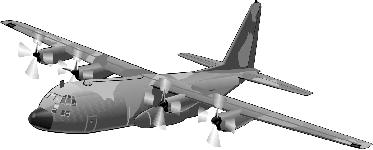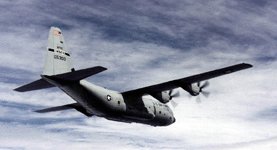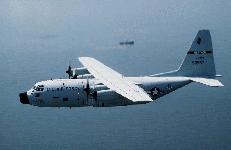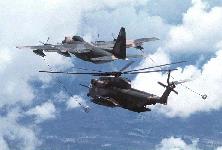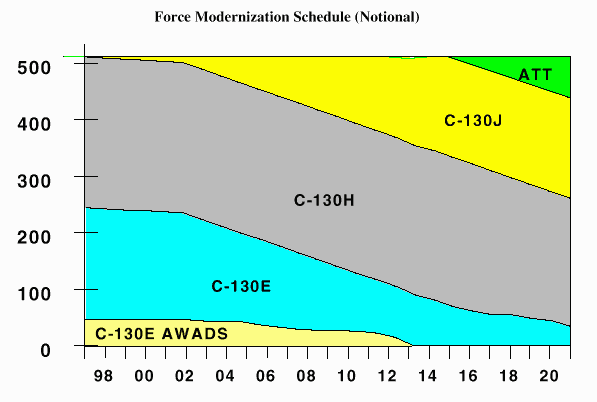



The C-130 Hercules primarily performs the intratheater portion of the airlift mission. The aircraft is capable of operating from rough, dirt strips and is the prime transport for paradropping troops and equipment into hostile areas. Basic and specialized versions perform a diversity of roles, including airlift support, DEW Line and Arctic ice resupply, aeromedical missions, aerial spray missions, fire-fighting duties for the US Forest Service, and natural disaster relief missions. In recent years, they have been used to bring humanitarian relief to many countries, including Haiti, Bosnia, Somalia, and Rwanda.
Four decades have elapsed since the Air Force issued its original design specification, yet the remarkable C-130 remains in production. The turbo-prop, high-wing, versatile "Herc" has accumulated over 20 million flight hours. It is the preferred transport aircraft for many US Government services and over 60 foreign countries. The basic airframe has been modified to hundreds of different configurations to meet an ever-changing environment and mission requirement. The C-130 Hercules has unsurpassed versatility, performance, and mission effectiveness. Early C-130A, B, and D versions are now retired.
| Missions | Specialized Variant |
|---|---|
| Tactical Airlift | All |
| Aerial Tanker | KC-130B, KC-130F, KC-13H, HC-130H(N), HC-130N, HC-130P, KC-130R, KC-130T |
| Command & Control | EC-130E (ABCCC), EC-130G, & EC-130Q |
| Maritime Patrol | C-130H-NP/PC-130H |
| Special Operations | MC-130E & MC-130H |
| Search & Rescue | SC-130B/HC-130B, HC-130E, HA-130H, HC-130H(N), HC-130N, & HC-130P |
| Humanitarian Relief | All |
| Staff/VIP Transport | VC-130B & VC-130H |
| Reconnaissance | RC-130B |
| Airborne Hospital | C-130E (AEH) |
| Arctic & Anarctic Support | C-130BL/LC-130F, C-130D, LC-130H, & LC-130R |
| Drone Control | GC-130A/DC-130A, DC-130E, & DC-130H |
| Electronic Warfare | EC-130E (CL), EC-130E (RR), EC-130H |
| Space & Missile Operations | JC-130A, JC-130B, & NC-130H |
| Test & Evaluation | NC-13A, NC-130B, JC-130E, NC-130E, JC-130H, & RC-130S |
| Weather Reconnaissance | WC-130B, WC-130E, WC-130H |
| Gunship | AC-130A, AC-130E, AC-130H, & AC-130U |
The initial production model was the C-130A, with four Allison T56-A-11 or -9 turboprops. Conceptual studies of the C-130A, were initiated in 1951. The first prototype flight took place in 1954 and the first production flight followed on April 7, 1955. A total of 219 were ordered and the C-130A joined the U.S. Air Force inventory in December 1956. Two DC-130A's (originally GC-130A's) were built as drone launchers/directors, carrying up to four drones on underwing pylons. All special equipment was removable, permitting the aircraft to be used as freighters, assault transports, or ambulances.
The C-130B introduced Allison T56-A-7 turboprops and the first of 134 entered Air Force service in April-June 1959. The B model carries additional fuel in the wings, and has upgraded engines and strengthened landing gear. C-130B's are used in aerial fire fighting missions by Air National Guard and Air Force Reserve units. Six C-130B's were modified in 1961 for snatch recovery of classified U.S. Air Force satellites by the 6593rd Test Squadron at Hickam Air Force Base, Hawaii.
Several A models, redesignated C-130D, were modified with wheel-ski landing gear for service in the Arctic and for resupply missions to units along the Distant Early Warning line. The two main skis are 20 feet long, six feet wide, and weigh about 2,000 pounds each. The nose ski is 10 feet long and six feet wide. The D model also has increased fuel capacity and provision for jet -assisted takeoff. The D models were flown by the Air National Guard and were recently replaced with C-130H models.
C-130E is an extended-range development of the C-130B, with two underwing fuel tanks and increased range and endurance capabilities. A total of 369 were ordered for MAC (now AMC) and TAC (now ACC), with deliveries beginning in April 1962. A wing modification to correct fatigue and corrosion on USAF�s force of C-130Es has extended the life of the aircraft well into the next century. Ongoing modifications include a Self-Contained Navigation System (SCNS) to enhance navigation capabilities, especially in low-level environments. The SCNS incorporates an integrated communications/ navigation management system that features the USAF standard laser gyro inertial navigational unit and the 1553B data bus; installation began in 1990. Other modifications include enhanced station-keeping equipment, 50 kHz VHF Omnirange/lnstrument Landing System (VOR/ILS) receivers, secure voice capability, and GPS capability. Another major modification installs a state-of-the-art autopilot that incorporates a Ground Collision Avoidance System. Military Airlift Command is the primary user, with more than 200 E models. The Air Force Reserve and Air National Guard also fly the E model.
Similar to the E model, the C-130H has updated T56-A-T5 turboprops, a redesigned outer wing, updated avionics, and other minor improvements. The C-130E/H carries 6,700 gallons of fuel in six integral wing tanks. Under each wing of the C-130E/H is an external pylon fuel tank with a capacity of 1,300 gallons. A pressure refueling point is in the aft side wheel well fairing for ground refueling. As a response to the role played by the tactical airlift fleet in Operation Just Cause and in the Persian Gulf War, Congress approved the procurement of more C-130H's to replace the aging E models. Delivery began in July 1974 [other sources state April 1975]. More than 350 C-130Hs and derivatives were ordered for active and reserve units of the US services, including eight funded in FY 1996. Production of the H has now ended. Units in Military Airlift Command, the Air National Guard and Air Force Reserve are equipped with this model. The Night Vision Instrumentation System was introduced from 1993; TCAS II in new aircraft from 1994. ANG and AFRC C-130Hs are used in fire-fighting missions. Specifically modified aircraft are used by the 757th AS, AFRC, based at Youngstown-Warren Regional Airport ARS, Ohio, for aerial spraying, typically to suppress mosquito-spread epidemics. Seven LC-130Hs, modified with wheel-ski gear, are operated by ANG�s 109th AW in support of Arctic and Antarctic operations.
While continuing to upgrade through modification, the Air Force has budgeted to resume fleet modernization through acquisition of the C-130J version. Compared to older C-130s, the C-130J climbs faster and higher, flies farther at a higher cruise speed, and takes off and lands in a shorter distance. This new model features a two-crew-member flight system, 6,000 skip Allison AE 21 00D3 engines and all-composite Dowty R391 propellers, digital avionics and mission computers, enhanced performance, and improved reliability and maintainability. Beginning in FY 1996, the Air Force started procuring C-130Js as replacements for the older C-130Es and Hs. Priority for replacement will be combat delivery aircraft. C-130J will ensure total force structure numbers are maintained, while reducing costs of ownership. The current program procures 12 C-130Js, i.e., two per year from FY96 to FY01. This program could be expanded in FY02 to procure 12 C-130Js a year to replace the active duty and ARC C-130Es which are nearing the end of their useable service life.
The WC-130E/H is used in weather reconnaissance and aerial sampling. The plane is modified to penetrate hurricanes and typhoons to collect meteorological data that make advanced warnings of such storms possible. Weather reconnaissance equipment gathers information on movement, intensity and size of storms; outside air temperature; humidity; dewpoint; and barometric pressure. WC-130s are assigned to active and Reserve units at Keesler Air Force Base, Miss.
The HC-130 is an extended-range, combat rescue version of the C-130 transport aircraft. Capable of independent employment in the no-to-low threat environment. Its primary mission is to provide air refueling for rescue helicopters. The HC-130 can perform extended searches in a permissive environment and has the capability to airdrop pararescuemen and survival equipment to isolated survivors when a delay in the arrival of a recovery vehicle is anticipated. Flights to air refueling areas or drop zones are accomplished at tactical low altitude to avoid threats. NVG-assisted, low-altitude air refueling and other operations in a low-threat environment are performed by specially trained crews. The crew can perform airborne mission commander (AMC) duties in a no-to-low threat environment when threat conditions permit. The maximum speed is 290 knots (at high altitude), with a low-altitude cruise speed of 210 to 250 knots. Range, depending upon internal fuel tank configuration, is 3,000 to 4,500NM (no wind).The C-130 Avionics Modernization Program (C-130X AMP) will modify approximately 525 aircraft to establish a common, supportable, cost effective baseline configuration for AMC, ACC, ANG, AFRC, PACAF, USAFE and AFSOC C-130 aircraft. The contractor will design, develop, integrate, test, fabricate and install a new avionics suite for approximately thirteen variants of C-130 Combat Delivery and Special Mission models. The installation schedule requires a throughput of between 65 and 85 aircraft per year through 2010. The acquisition strategy is currently in development. The C-130 AMP is being worked jointly by Warner-Robins ALC (GA) and Aero Systems Center (OH) (virtual SPO) with the Development System Manager located at ASC.
The United States Marine Corps has chosen the KC-130J tanker to replace its aging KC-130F tanker fleet. The new KC-130J offers increased utility and much needed improvement in mission performance. As a force multiplier, the J tanker is capable of refueling both fixed wing and rotary wing aircraft as well as conducting rapid ground refueling. The refueling speed envelope has been widened from 100 to 270 knots indicated airspeed, offering more capability and flexibility. Offload rates per refueling pod can be up to 300 gallons / 2,040 lbs (1,135 liters / 925 kg) per minute simultaneously. The J tanker's offload is significantly greater than previous Herc tankers. As an example, at 1,000 nautical miles, the fuel offload is well over 45,000 lbs. Rapid ground refueling is also a premium capability. In austere conditions/scenarios, the KC-130J can refuel helicopters, vehicles, and fuel caches at 600 gallons / 4,080 lbs (2,270 liters / 1,850 kg) per minute. Additionally, the unique prop feathering capability while the engines are still running ("HOTEL Mode") offers safer and more hospitable conditions for ground refueling than in the past.
The WC-130J Hercules is a special weather reconnaissance version of the new Lockheed Martin C-130J cargo plane. Its mission is to fly into the eye of hurricanes to retrieve critical information about active storms. The Air Force Reserve Command's 53rd Weather Reconnaissance Squadron at Keesler Air Force Base, MS, a component of the 403rd Wing, is the only unit in the Department of Defense that flies this mission.
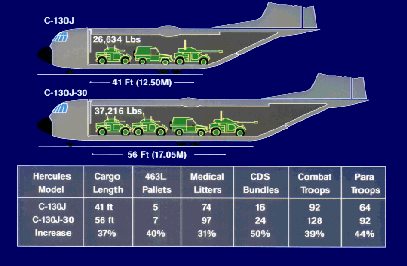
For the first time in the 40-plus year history of the popular Hercules transport, the US Air Force and Lockheed Martin Aeronautical Systems signed a commercial practices contract for the sale of C-130Js. Awarded on 06 November 1996, the basic contract includes an initial order for two aircraft, associated data, and spares, funded in fiscal year 1996. The contract also contains five years of options through the year 2000 for additional aircraft, interim contractor support, data, training, and support. By late 1996 Aeronautical Systems had completed assembly of the first "production" C-130J (Serial # 5440), one of 12 ordered by the Royal Australian Air Force.
In its personnel carrier role, the C-130 can accommodate 92 combat troops or 64 fully equipped paratroops on side-facing seats. For medical evacuations, it carries 74 litter patients and two medical attendants. Paratroopers exit the aircraft through two doors on either side of the aircraft behind the landing-gear fairings. Another exit is off the rear ramp for airdrops.
The C-130 can deliver personnel, equipment or supplies either by landing or by various aerial delivery modes. Three primary methods of aerial delivery are used for equipment.
The C-130's design maximum gross weight is 155,000 pounds (175,000 pounds wartime) with a normal landing weight of 130,000 pounds. The operating weight is approximately 80,000 pounds. The airplane is capable of airlifting 92 ground troops, 64 fully equipped paratroopers, or 74 litter patients. It can also carry 45,000 pounds of cargo.
FUSELAGE: The fuselage is a semimonocoque design and divided into a flight station and a cargo compartment. Seating is provided for each flight station. The cargo compartment is approximately 41 feet long, 9 feet high, and 10 feet wide. Loading is from the rear of the fuselage. Both the flight station and the cargo compartment can be pressurized to maintain a cabin pressure-altitude of 5000 feet at an aircraft altitude of 28,000 feet.
WINGS: The full cantilever wing contains four integral main fuel tanks and two bladder-type auxiliary tanks. Two external tanks are mounted under the wings. This gives the C-l 30 a total usable fuel capacity of approximately 9680 U.S. gallons.
EMPENNAGE: A horizontal stabilizer, vertical stabilizer, elevator, rudder, trim tabs, and a tail cone make up the empennage. This section consists of an all-metal full cantilever semimonocoque structure. It is bolted to the aft fuselage section.
POWER PLANT: (prior to the C-130J) Four Allison turboprop engines are attached to the wings. The engine nacelles have cowl panels and access doors forward of a vertical firewall. Clam-shell doors are located aft of the vertical firewall. Air enters the engine through a scoop assembly at the front of the nacelle.
PROPELLERS: (prior to the C-130J) Four Hamiliton Standard electro-hydromatic, constant-speed, full feathering, reversible-pitch propellers are installed on each engine.
LANDING GEAR AND BRAKES: The modified tricycle-type landing gear consists of dual nose gear wheels and tandem mains. Main gear retraction is vertically, into fuselage fairings, and the nose gear folds forward into the fuselage. Power steering is incorporated into the nose gear. The landing gear design permits aircraft operation from rough, unimproved runways. The brakes are hydraulically operated, multiple-disc type. The braking system incorporates differential braking and parking brake control. A modulating anti-skid system is provided.
AUXILIARY POWER UNIT (APU) (C-130H): The APU supplies air during ground operation for engine starting and air conditioning. One 40 KVA AC generator is mounted on the APU as an additional AC power source. Emergency electrical power during flight is also available up to 20,000 feet.
GAS TURBINE COMPRESSOR (GTC) AND AIR TURBINE MOTOR (ATM) (C-130E): C-13OE model aircraft have a GTC which supplies bleed air for engine start, air conditioning, and operation of an ATM. The ATM powers a 20 KVA electrical generator to supply auxiliary electrical power on the ground only.
OIL: The C-130 has four independent oil systems with a 12 gallon capacity for each engine. Oil is serviced through a filler neck located on the upper right engine cowling.
FUEL: The fuel system consists of a modified manifold-flow type incorporating fuel crossfeed, single point refueling (SPR) and defueling, and fuel dumping. Latest USAF versions incorporate blue foam for fire suppression.
ELECTRICAL: AC electrical power for the C-130H model is provided by five 40 KVA generators, 4 driven by the engines and one driven by the APU. On the E model, the power is supplied by four 40 KVA engine-driven generators, and a 20 KVA generator driven by the ATM. DC power is provided from AC sources through four 200 ampere transfomer rectifiers and one 24 volt, 36 ampere-hour battery.
HYDRAULIC: Four engine-driven pumps supply 3000 psi pressure to the utility and booster systems. An electric AC motor-driven pump supplies pressure to the auxiliary system and is backed up by a handpump. The hydraulic system maintains constant pressure during zero or negative "g" maneuvers.
AIR CONDITIONING AND PRESSURIZATION: Two independent air conditioning systems for the flight deck and cargo compartment are operated from engine bleed air in flight and by the GTC/APU on the ground.
OXYGEN: Both models have a 25 liter liquid oxygen (LOX) type system which provides for 96 man-hours of oxygen at 25,000 feet. It uses diluter-demand automatic pressure-breathing regulators. Portable units are also provided. System pressure is maintained at 300 psi.
FLIGHT CONTROLS: The primary flight control system consists of conventional aileron, elevator, and rudder systems. Hydraulic power boost is incorporated in each system.
WING FLAPS: The wing flaps are high-lift, Lockheed-Fowler type and are of conventional design and construction. Normal operation is by hydraulic motor. Emergency operation is by manual crank.
ANTI-ICING: Engine bleed air is used for anti-icing the wing and empennage leading edges, the radome, (radome anti-icing may be removed in some models, check with aircraft forms) and engine inlet air ducts. Electrical heat provides anti-icing for the propellers, windshield, and pitot tubes.
AIRCRAFT DIMENSIONS:
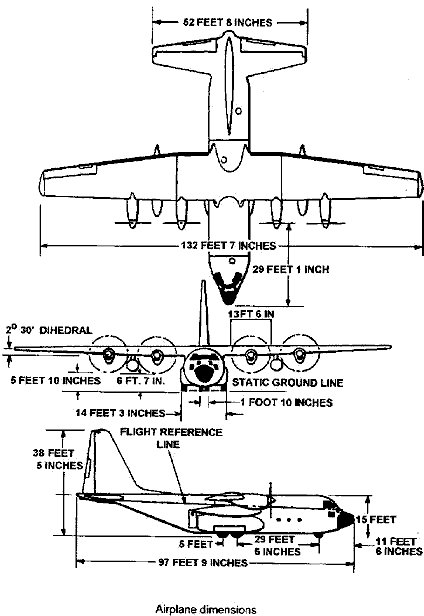 |
Wing Span: Length: Height: Horizontal Stabilizer: |
132 feet 7 inches 97 feet 9 inches 38 feet 5 inches 52 feet 8 inches |
Typical C-130 Cargo Dimensions:
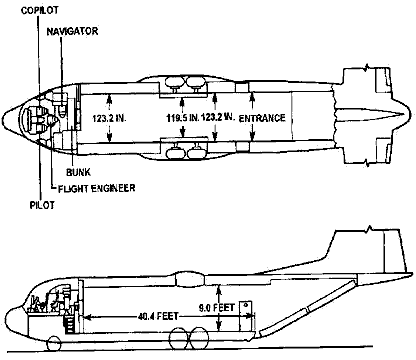
| Model | First Delivery | Last Delivery |
|---|---|---|
| C-130A | 1956 | Nov 1959 |
| C-130B | 1959 | Mar 1963 |
| C-130E | 1962 | Mar 1974 |
| C-130H | 1964 | In Production |
| C-130H2 | 1978 | 1992 |
| C-130H3 | 1992 | 1997 |
| C-130J | 1996 | In Production |
| L-100 | 1964 | Dec 1968 |
| L-100-20 | 1968 | Mar 1981 |
| L-100-30 | 1970 | In Production |
| C-130H-30 | 1980 | 1997 |

Specifications | |
| Primary Function | Intratheater airlift. |
| Contractor | Lockheed Aeronautical Systems Company. |
| Power Plant | Four Allison T56-A-15 turboprops; 4,300 horsepower, each engine. |
| Length | 97 feet, 9 inches (29.3 meters). |
| Height | 38 feet, 3 inches (11.4 meters). |
| Wingspan | 132 feet, 7 inches (39.7 meters). |
| Speed | 374 mph (Mach 0.57) at 20,000 feet (6,060 meters). |
| Ceiling | 33,000 feet (10,000 meters) with 100,000 pounds (45,000 kilograms) payload. |
| Maximum Takeoff Weight | 155,000 pounds (69,750 kilograms). |
| Operating Weight: | 83,000 Pounds |
| Maximum Useable Fuel: | 60,000 Pounds |
| Maximum Allowable Cabin Load: | 36,000 Pounds |
| Normal Passenger Seats Available: | Up to 92 troops or 64 paratroops or 74 litter patients. |
| Maximum Number of Pallets: | 5 |
| Range | 2,356 miles (2,049 nautical miles) with maximum payload; 2,500 miles (2,174 nautical miles) with 25,000 pounds (11,250 kilograms) cargo; 5,200 miles (4,522 nautical miles) with no cargo. |
| Unit Cost | $22.9 million (1992 dollars). |
| Crew | Five (two pilots, a navigator, flight engineer and loadmaster); up to 92 troops or 64 paratroops or 74 litter patients or five standard freight pallets. |
| Minimum Crew Complement | Four (two pilots, one flight engineer, and one loadmaster) Allows for a 16 hour crew duty day (12 hour for airdrop crews) (from show at the aircraft to parking at the final destination). |
| Crew Complement [airdrop missions] |
Six crews will normally carry one navigator as well and an extra loadmaster in addition to the minimum crew complement. |
| Augmented Crew Complement | Nine (three pilots, two navigators, two flight engineers, and two loadmasters) Allows for a 18 hour crew duty day (from show at the aircraft to parking at the final destination) |
| Date Deployed | April 1955. |
| Inventory | Active force, 98; ANG, 20 Bs, 60 E's and 93 H's; Reserve, 606. |
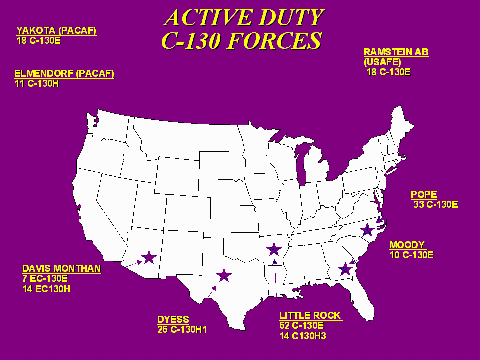
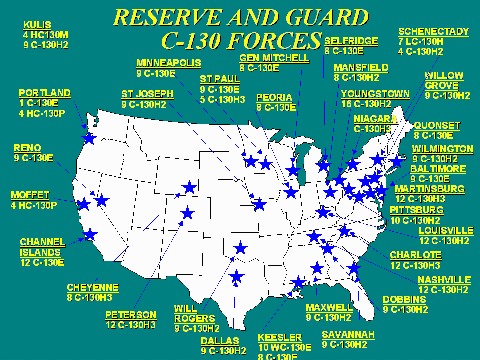
| VRML 3-D Model |
 C-130 Hercules VRML by Soji Yamakawa |

